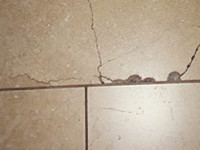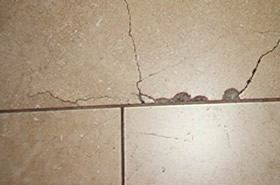Got cracks?
what can you do when your tile and/or grout is cracking?
Adam Bartos of BiO Tile & Grout Restoration offers some solutions
Tile and grout restoration contractors encounter many problems with tile and grout flooring, but the most common problem seems to be cracking. If your tile and/or grout is cracking, you may want to ask your restoration contractor about the solutions in this article.
Depending on what’s happening underneath the flooring, cracking may be caused by, among other things, structure settlement or weak underlayment.
Structure Settlement
When the conditions of soil under a house change because of moisture or soil shifting, a downward movement, or settling of the structure may occur. Often, this movement is not structurally significant, but it can cause problems with building materials, including floors. If cracking in tile and grout is caused by settlement, fixing the problem may be a complicated and expensive ordeal. Sections of the floor and underlayment (the material between the floor and the foundation) must be removed, cracks deep underneath must be repaired, and then the floor has to be rebuilt. Most floor restoration contractors leave this type of heavy-duty repair to building contractors.
Weak Underlayment
On the other hand, flooring that is installed on a weak underlayment may also have problems with cracking. When we walk over floors, we apply a lot of pressure over a small area. If that pressure causes the underlayment to flex, then tile and grout flooring, which is not designed to be flexible, weakens. In time, the grout loosens or cracks, and tiles become hollow, or worse, they crack. If weak underlayment is the diagnosis, there may be two easy and inexpensive ways to resolve some cracking problems.
Case Study #1
Homeowners in Palatine, IL
A very frustrated couple had called three different restoration contractors on three different occasions because of problems with the grout in their floor cracking year after year. They wondered whether the floor needed to be replaced entirely and called us as a last resort. I knew right away that if three different companies had tried to fix the problem by replacing the grout, then doing the same thing a fourth time would obviously not be a viable solution.
We set up a consultation. When I closely examined the floor, while the homeowner took a few steps, I clearly saw some of the tiles flexing under his feet, — an indication that tiles were separating from the underlayment.
The Solution
The challenge was to find the best way to fill the voids under the tile. Our solution was to use a tile glue called “Inject-A-Floor” made by a company in Boca Raton, Florida. First, we drilled 1/8 inch holes around the perimeter of the hollow tiles so that the holes went through to the underlayment. After vacuuming the debris, we used a big 80 cc syringe with a needle to inject the glue. The glue, since it is liquid, finds its way into any void. For example, the glue that had been injected into holes on one side of a tile surfaced from the holes on the opposite side, a clear indication of the glue flow underneath the tile. The glue took 24 hours to dry.
This procedure, in itself, did not fully resolve the problem, only the hollow tiles. The other part of the problem was weak underlayment, which couldn’t be easily changed. We had already ruled out using regular grout, because of the history of this floor. Using epoxy grout would only have made matters worse, because epoxy grout dries extremely hard. With the glue in place, the tiles were not going to give, and if the grout was inflexible as well, either the tile or the new grout would inevitably crack again. Although it is easier to replace cracked grout than cracked tiles (because most owners don’t have replacement tiles), we needed to find a long-term solution. After all, the customer had to live with the floor.
A flexible grout called QuartzLock 2 was our best solution. It is a pre-mixed, ready-to-use urethane and colored quartz-based grout that is very easy to install. It requires no sealing and is resistant to typical food stains and most household chemical products. The advantage of this type of grout is when it dries, it becomes flexible, and if there is any movement in the floor, the grout flexibility dissipates the stress that would otherwise put pressure on the tile.
The Result
The wife loved the color of the grout. She was so happy to see the floor looking uniform again and relieved that we didn’t leave them with just another patch on the floor. The husband was hesitant to believe their problem was solved. Only the passing of time would convince him. He called me about three months later and told me the problem was indeed solved and that neither tiles nor grout had cracked with normal usage.
Case Study #2
Homeowners in Dundee, IL
In northern states, floors are often installed over either an electrical or water-type floor heating system. This makes floor replacement or repair very difficult. One tiny fracture in the heating system can destroy the heating element, which can cost thousands of dollars to replace.
For this reason, the customer asked me if we could solve his floor problem. Several tiles in the front of his shower were hollow, nearly lifting off the floor but still attached. We did not want to simply pull up and then reset the tile for two reasons. First, we might crack tiles, and the customer did not have any replacements. Second, the floor heating system could be damaged during the repair process.
Replacing the floor would have been a very expensive and time-consuming project, not only because of the cost of replacing the heating system and flooring, but also because the cabinets and baseboards were all built directly on top of the tile floor. Everything would have had to be removed from the bathroom.
I provided a fix that was fast, easy, and only cost the customer about $400, a cheap alternative compared to the thousands it could have cost. We injected the glue under the lifting tiles, and his problem was resolved.
Case Study #3
Homeowner in Buffalo Grove, IL
A homeowner’s floor was only one and a half years old, yet the grout was cracking. During consultation, we noticed that a few tiles were hollow. Upon further investigation through the ventilation system, we discovered that the underlayment of the floor was quite solid, built up with two layers of ¾ inch plywood. We were stumped at what could possibly be causing the problems with her floor.
While we were there the homeowner started a load of laundry. My technicians pointed out that the washer was vibrating, and the vibrations were being transmitted into the floor.
Mystery Solved
Vibration can cause flooring to separate from the underlayment. For example, when workers remove asphalt or concrete, they use automatic hammers that employ vibration to break up the hard materials. Though not as powerful as a jackhammer, if a washing machine transmits vibration into a floor, it can cause the construction of the flooring to fail.
The Solution
In this floor, there was mortar or adhesion between the tiles and the underlayment. We injected quite a bit of glue underneath the hollow tiles, and then regrouted with regular grout. We told the customer that we could replace the standard grout with flexible grout, but she opted for color sealing instead, to hide the little marks left by the drill bits and the variation between the new and old grout. (If you don’t know about color sealing, you can find an article from Issue 2, Vol. 1 here.) Additionally, we recommended that she put a barrier, such as rubber grommets or a rubber mat, between the vibrating washer and floor surface, to minimize future vibration damage to the flooring. When we checked with her sometime later, she told us that the grout was still intact, and that she had no issues whatsoever.
Case Study #4
Homeowner in Naperville, IL
In a very, very expensive home, probably 2 million dollars or more, there was a beautiful bush-hammered, tumbled limestone floor. But in the hallway, there were two steps where the grout kept cracking, no matter how many times it was repaired. The home builder finally said, “I’m giving up. I don’t know what is going on.” That’s when the homeowner called us to take a look.
I noticed the tiles on the steps were laid directly on a base of 2×4’s. Someone had made a mistake in the building process, and there were holes going all the way through to an empty area behind the base. The tiles were very strong and heavy, about ¾ to one inch thick, which put additional stress on the floor structure. In this situation, there was nothing underneath to hold the tiles and grout together, and the result was hollow tiles and cracking grout.
Unfortunately for us and for the customer, we could not inject glue, because there was nothing to hold the glue underneath the tiles. It would just slip straight through to the empty space behind the base.
The Solution
Instead of rebuilding the entire hallway, which would entail the near-impossible task of finding stone tiles to match the existing floor, we decided to use the flexible grout to regrout a ten square foot area. Because the builders made the mistake before the flooring was installed, this was not a permanent fix. But for the homeowner, this resolution was preferable to ripping up the tile and rebuilding the hallway and steps. I spoke with the customer recently, and she said everything is still fine.
___________________________________________________________
Some additional notes:
how do you know if your tile is hollow?
Knock on an individual tile. If you hear an empty sound, as if there is an empty container underneath it, then the tile is likely in the process of separating from the underlayment.
Perhaps it is still partially attached at a corner or somewhere in the middle, but separation is taking place. It’s just a matter of time before a hollow tile begins to crack.
flexible grout: a win-win solution
Even if you aren’t planning to DIY, using flexible grout can be a win-win situation for both the customer and the installer.
- For the customer
Flexible grout is urethane-based, which means it does not stain and does not ever need to be sealed. For repairs due to improper underlayment, flexible grout is less expensive than replacing the entire floor. - For the installer
Flexible grout is much easier to install than epoxy grout.
the DIY advantage
If you are working on a DIY tile project, and want to do it little by little, as time allows, you might consider using flexible grout. With normal grout, you can lay the tile a little at a time, but you have to grout the entire area at once. The reason is that the amount of water used in each batch of grout varies to some extent, causing each batch of grout to cure to a slightly different color.
With the flexible grout, since it is already premixed, you are going to have the same color every time you use it. Leftover grout can be stored for two years or longer, as long as you put the lid firmly back on the bucket. You can do the work in sections without patchy results. And because flexible grout is a urethane-based product, the amount of water you use to clean it will not affect the color of the grout.
————
BiO Tile & Grout Restoration is fully licensed and insured, and serves the northern Chicagoland area. BiO Tile & Grout Restoration offers a unique way to clean and restore hard surfaces such as ceramic or porcelain tile, slate, travertine, limestone, marble, granite, concrete, paver bricks, etc. and uses the highest quality sealers to extend their life.
You can visit them at www.restoreyourtiles.com.



 Google map
Google map Facebook
Facebook